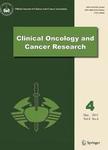Synergistic Action of Clonorchiasis,HBV Infection and Alcohol Consumption on Primary Hepatocellular Carcinoma
Synergistic Action of Clonorchiasis,HBV Infection and Alcohol Consumption on Primary Hepatocellular Carcinoma作者机构:Department of Preventative Medicine Guilin Medical ColLege Guilin 541001 Guangxi Zhuang Autonomous Region China Department of Epidemiology School of Public Health Guangxi Medical University Nanning 530021 Guangxi Zhuang Autonomous Region China Department of Hepatobiliary Surgery The First Hospital of Guangxi Medical UniversityNanning 530021 Guangxi Zhuang Autonomous Region China
出 版 物:《Chinese Journal of Clinical Oncology》 (中国肿瘤临床(英文版))
年 卷 期:2009年第6卷第2期
页 面:104-112页
核心收录:
学科分类:1004[医学-公共卫生与预防医学(可授医学、理学学位)] 1002[医学-临床医学] 100214[医学-肿瘤学] 100401[医学-流行病与卫生统计学] 10[医学]
基 金:supported by a grant from the National Natural Science Foundation of China(No.30660162)
主 题:primary hepatocellular carcinoma risk factor clonorchiasis HBV infection alcohol consumption synergistic action.
摘 要:OBJECTIVE It has been recognized that HBV infection and alcohol consumption are two important risk factors for primary hepatocellular carcinoma (HCC). Recently, the role of clonorchiasis as a risk factor for HCC is controversial. We aimed to investigate whether these factors increase the risk of HCC in Guangxi, China. METHODS A hospital-based, case-control study of HCC was conducted from July 2005 to July 2007. We enrolled 500 consecutive patients with HCC as an experimental group and 500 patients without tumor in liver as a control group. The risk factors that the patients were exposed to were assessed. RESULTS Comparing the risks of developing the HCC, we found out the following results. The risk of developing HCC for the patients with clonorchiasis was 5 folds of that for the patients without clonorchiasis (OR = 5.0; 95% CI: 3.1-8.1), and the risk for the patients with alcohol consumption was 3 folds of that for the patients without drinking alcohol (OR = 3.4; 95% CI: 2.3-4.9), and similarly, the risk for the patients with HBV infection was 21 times of that for the patients without HBV infection (OR = 20.6; 95% CI: 14.3-29.7). According to crossover analysis, there was significant interaction among clonorchiasis, HBV infection and alcohol consumption, with synergistic indices greater than 1. The etiologic fractions attributed to these interactions [EF (A × B)] are 0.7465, 0.5789 and 0.5506, respectively. CONCLUSION Clonorchiasis, HBV infection and heavy alcohol consumption are independent risk factors for developing HCC in our population in Guangxi, and as they can interact synergistically, the risk of developing HCC is increased. Data from this study may indicate new prevention strategies of developing HCC in high-risk individuals.



